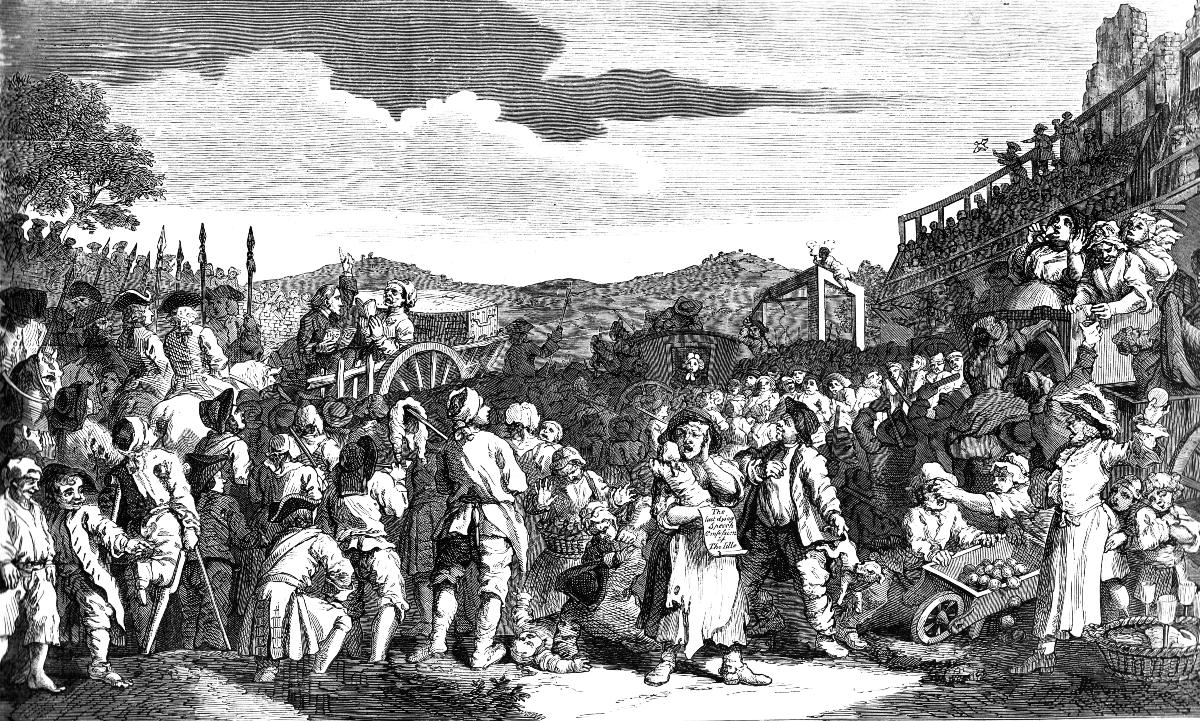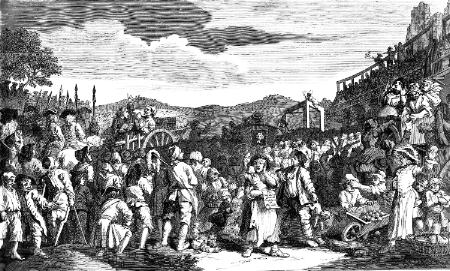
|

|
The amazing web site of Shakespeare's Sonnets. Industry and Idleness. Plate 11. The Idle Apprentice executed at Tyburn , by Hogarth.
HAKESPEARE'S
ONNETS
This is part of the web site of Shakespeare's sonnets
PICTURE GALLERY.
William Hogarth 1697 - 1764.
| Hogarth
first achieved fame as an artist through his series of moralistic
engravings, commencing with A
Harlot's Progress
in 1731. This was followed by A
Rake's Progress
in 1735, Marriage
ŕ-la-mode
in 1743-5, and Industry
and Idleness in
1747
. Originally the sets of pictures were oil
paintings which
Hogarth subsequently published as engravings. However the
Industry and Idleness series was conceived entirely as a set
of engravings which were not copied from paintings. They were
put on sale for one shilling each, which is equivalent today, (2008),
to about ten pounds sterling (GBP). Evidently Hogarth was
trying
to appeal to a wider audience than the upper class wealthy who were his
usual patrons. The Industry and Idleness series is rather crudely moralistic, depicting how industry and virtue are rewarded with worldly success, while idleness, corruption and vice is ultimately punished by the gallows. Despite this rather tedious tale, which is not true to life and simplistically misrepresents the apprenticeship system of the time, the engravings are a superb record of both the lower and upper end of London life of the time. The banqueting scene of Plate 8 and the two final crowd scenes of the Tyburn spectacle and the Lord Mayor's Parade are incomparable and show the satirical Hogarth at his very best. |
||
| In this multifarious scene Tom Idle is carried in a cart from Newgate to Tyburn, the place of execution. For the crowds of London it is a holiday event. Tom is being preached at by a Methodist minister who holds a book with the word 'Wesley' on the cover. He himself seems to be reading a prayer book. Soldiers follow the condemned man's cart. In the background stands the Tybuirn gallows, a three cornered structure, designed to allow multiple hangings. The executioner lolls on top of it casually smoking a pipe. Above him a man releases a pigeon bearing the news to Newgate that the condemned man has reached Tyburn, so they may commence tolling the bell. Hoi polloi in the foreground are variously engaged in fighting, drinking, pick-pocketing, selling of cakes and fruit. A man carries a dog by its tail, perhaps preparing to hurl it into the crowd. He appears to be eyeing up the ballad seller, who is selling the ,The Last Dying Speech and Confession of Thomas Idle', clearly a fictitious work. The man in the carriage in the middle distance is the clergyman who will conduct the ceremony at the man's death. I have not been able to discover what the objects are around the basket on the bottom right of the picture, nor why the man left of centre appears to be carrying a wig on a stick. | ||


Shakespeare's Sonnets:
| Start here with the first sonnet |
|
Sonnets 1 - 50 | Some links to other sites | ||
|
|
Sonnets 51 - 100 | ||||
|
|
|
Sonnets 101 - 154 | For
a global search use all the sonnets as
plain text 1-154 or use the first line index. |
If
you have enjoyed this web site, please
visit its companion - Pushkin's Poems |
|
| Map of the site | |||||
| Views of London as it was in 1616. |
London Bridge As it was in Shakespeare's day, circa 1600. |
To
search for a line or phrase in the sonnets
go to the sonnets as plain text and use the browser text search engine. |
| Views of London as it was in 1616. |
London Bridge As it was in Shakespeare's day, circa 1600. |
To search for a line or phrase in the sonnets
go to the Sonnets as plain text and use the browser text search engine. |
| Sonnets 1 - 50 | Back to home page | |
| Sonnets 51 - 100 | If
you have enjoyed this web site, please
visit its companion - Pushkin's Poems |
|
| Sonnets 101 - 154 | If you wish to comment on this site please refer to details on the home page. | |
| Copyright Šof this site belongs to Oxquarry Books Ltd |

Copyright Šof this site belongs to Oxquarry Books Ltd